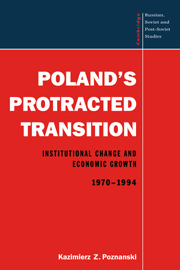Book contents
- Frontmatter
- Contents
- Preface
- Introduction: Research agenda, conceptual model and principal findings
- Part I Imperfect decentralization, broken political contracts and foreign-debt crisis
- Part II Economic reforms, divided society and ‘growth fatigue’
- 4 Anti-crisis policies and elusive economic recovery
- 5 Foreign trade developments: underutilized potential
- 6 Political struggles and economic malaise
- Part III Communist legacy, ‘shock therapy’ and economic recession
- Appendix
- Notes
- References
- Index
- Titles in the series
6 - Political struggles and economic malaise
Published online by Cambridge University Press: 29 October 2009
- Frontmatter
- Contents
- Preface
- Introduction: Research agenda, conceptual model and principal findings
- Part I Imperfect decentralization, broken political contracts and foreign-debt crisis
- Part II Economic reforms, divided society and ‘growth fatigue’
- 4 Anti-crisis policies and elusive economic recovery
- 5 Foreign trade developments: underutilized potential
- 6 Political struggles and economic malaise
- Part III Communist legacy, ‘shock therapy’ and economic recession
- Appendix
- Notes
- References
- Index
- Titles in the series
Summary
With the evidence offered in the previous chapter that many of the problems with the foreign sector may have had their source in the domestic sector, we are going to look in this closing chapter of the second part at the political forces which could have shaped the internal economy. This stage of our analysis should provide a proper context for understanding the debt-repayment difficulties as well as overall economic performance. We look at the politics of economic choice from the imposition of martial law in late 1981 to the collapse of the communist party/state in mid-1989. We have already established that the economic fortunes of the Gierek government were heavily influenced by political developments, many of them outside of government's control. This part of our analysis provides an opportunity to establish whether politics continued to greatly affect economics in the years that followed the cabinet's departure.
We assert below that during the period of martial law the political leadership of Jaruzelski was able to bring about the near-pacification of society – albeit without its conscious cooperation. Direct clashes of the opposition with the military-run political apparatus had proved too costly to rioters, and therefore lost much of their appeal for the public at large. Consequently, forms of dissent changed as organized and visible protests were replaced by less noticeable or structured acts of defiance. The harsh steps taken by the Jaruzelski regime to stabilize the political situation only produced an ‘unstable equilibrium,’ which was quite easily disturbable.
- Type
- Chapter
- Information
- Poland's Protracted TransitionInstitutional Change and Economic Growth, 1970–1994, pp. 139 - 166Publisher: Cambridge University PressPrint publication year: 1997



